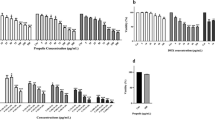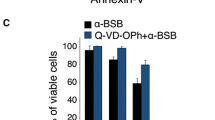Summary
The anticancer activity of trichostain A (TSA) on human B cell non-Hodgkin’s lymphoma and its mechanism were explored. The effect of TSA on the growth of Raji cells and normal peripheral blood mononuclear cells (NPBMNC) was studied by MTT assay. The effect of TSA on the apoptosis of Raji cells and NPBMNC was studied by flow cytometry and TDT-mediated dUTP nick end labeling (TUNEL). The effect of TSA on the cell cycle of Raji cells was studied by propidium iodide method. The results showed that TSA potently inhibited proliferation of Raji cells at microgram concentrations and induced apoptosis of Raji cells in a time-and concentration-dependent manner. Treatment with TSA induced accumulation of cells in G0/G1 or G2/M and a concomitant decrease of cell population in S phase. However, NPBMNC was less sensitive to the cytotoxic effect of TSA than Raji cells. It was concluded that TSA may inhibit the proliferation of Raji cells by regulating the cell cycle and inducing the cell apoptosis. Moreover, TSA demonstrates low toxicity in NPBMNC but selectively induces apoptosis of Raji cells.
Similar content being viewed by others
References
Cress W D, Steo E. Histone deacetylase, transcriptional control and cancer. J Cell Physiol, 2000,184:1–16
Chen W K, Chen Y. Histone acetylation: new target for leukemia treatment. Clin J Hematol (Chinese), 2002,15:233–234
Finnin M S, Donigian J R, Cohen A et al. Structures of a histone deacetylase homologue bound to the TSA and SAHA inhibitors. Nature, 1999,401:188–193
Wang Z M, Hu J, Zhou D et al. Trichostatin A inhibits proliferation and induces expression of P21WAF and P27 in human brain tumor cell lines. Chin J Cancer (Chinese), 2002,21:1100–1105
Herold C, Ganslmayer M, Ocker M et al. The histone-deacetylase inhibitor Trichostatin A blocks proliferation and triggers apoptotic programs in hepatoma cells. J Hepatol, 2002,36:233–240
Mosmann T. Rapid colorimetric assay for cellular growth and survival: application to proliferation and cytotoxicity assays. J Immunol Methods, 1983,65:55–63
Park W H, Jung C W, Park J O et al. Trichostatin inhibits the growth of ACHN renal cell carcinoma cells via cell cycle arrest in association with p27, or apoptosis. Int J Oncol, 2003,22:1129–1134
Medina V, Edmonds B, Young G P et al. Induction of caspase-3 protease activity and apoptosis by butyrate and trichostatin A (inhibitor of histone deacetylase): dependence on protein synthesis and synergy with a mitochodrial/cytochrome c-dependent pathway. Cancer Res, 1997,57:3697–3707
Murata M, Towatari M, Kosugi H et al. Apoptotic cytotoxic effects of a histone deacetylase inhibitor, FK228, on malignant lymphoid cells. Jpn J Cancer Res, 2000,91:1154–1160
Owa T, Yoshino H, Yoshimatsu K et al. Cell cycle regulation in the G1 phase: a promising target for the development of new chemotherapeutic anticancer agents. Curr Med Chem, 2001,8:1487–1503
Huaang L, Pardee A B. Suberoylanilide hydroxamic acid as a potential therapeutic agent for human breast cancer treatment. Mol Med, 2000,6:849–866
Sowa Y, Sakai T. Butyrate as a model for “gene-regulating chemoprevention and chemotherapy”. Biofactors, 2000,12:283–287
Munster P N, Troso-Sandoval T, Rosen N et al. The histone deacetylase inhibitor suberoylanilide hydroxamic acid induces differentiation of human breast cancer cells. Cancer Res, 2001,61(23):8492–8497
Hoshikawa Y, Kwon H J, Yoshida M et al. Trichostatin A induces morphological changes and gelsolin expression by inhibiting histone deacetylase in human carcinoma cell lines. Exp Cell Res, 1994,214:189–197
Vigushin D M, Ali S, Pace P E et al. Trichostatin A is a histone deacetylase inhibitor with potent antitumor activity against breast cancer in vivo. Clin Cancer Res, 2001,7(4):971–976
Author information
Authors and Affiliations
Additional information
This project was supported by a grant from National Natural Sciences Foundation of China (No. 30271672).
Rights and permissions
About this article
Cite this article
Sun, C., Liu, X., Chen, Y. et al. Anticancer activities of trichostatin A on malignant lymphoid cells. J. Huazhong Univ. Sc. Technol. 26, 538–541 (2006). https://doi.org/10.1007/s11596-006-0513-8
Received:
Issue Date:
DOI: https://doi.org/10.1007/s11596-006-0513-8




